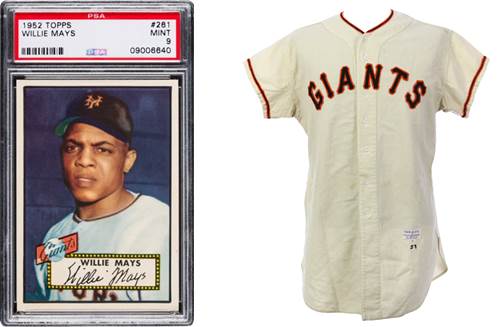With each passing year, there are fewer and fewer of them left. I am not talking about cards or jerseys (yet), but rather those great players from the high water mark of 20th century major league baseball. The time reference for this is the 1950s and early 1960s. The major league landscape was filled with the likes of Mantle, Aaron, and Musial…Berra, Campanella, and Williams… Mays, Snider, and Banks. These players and many from the same timeframe launched an industry of sports memorabilia collectables when the baby boomers who worshiped them gained a dose of nostalgia as well as disposable income during the 1980s and early 1990s.
Last month, we were treated to some significant offerings of one of the few surviving icons of the period; Willie Mays. Heritage Auctions offered a 1952 Willie Mays Topps #261 in PSA Mint 9. Grey Flannel Auctions stepped up to the plate with a 1957 Willie Mays New York Giants home jersey. For the life of me, I am struggling to wrap my head around the results.
The 1952 Topps Mays sold for $478,000 and the 1957 Mays jersey sold for $222,036; or less than half of what the card went for. Having been intimately involved in researching and tracking 20th century major league baseball uniforms for well over two decades, I had to look into this, hoping to make some sense of it. My first stop was the PSA Population Report where I saw that there have been thirteen 1952 Mays cards that have graded at Mint 9. Overall, PSA shows a total of 1,691 graded 1952 Topps Mays cards. For subsequent years while the “Say Hey Kid” was still roaming the cavernous Polo Grounds:
1953: 3 in Mint 9 or better; 1,464 overall
1954: 12 in Mint 9; 2,542 overall
1955: 12 in Mint 9; 2,058 overall
1956: (For both white and gray back) 33 in Mint 9; 3,427 overall
1957: 28 in Mint 9; overall 3,277
Now mind you, PSA is only one of the organizations who grades cards, so the overall numbers would have to be somewhat higher. That being said for Topps Baseball Cards of Willie Mays during his tenure with the fabled New York Giants, there are almost ninety in Mint 9 and over 14,400 overall. I put myself through this drill so I could have some understanding of perceived rarity as I am much more familiar with uniform populations. I have been data basing uniforms since the late 1990s, and to the best of my knowledge, there are 3-4 legitimate surviving Willie Mays New York Giants jerseys in private collections.
Not understanding the price difference between the 1952 Topps Mays and the 1957 Mays Home jersey (which I have since seen and it is exquisite), I headed to the dry erase board and tried to brain storm on what might make these graded cards so popular since it is certainly not comparative rarity when it comes to uniforms. I came up with (in no particular order):
- You don’t need to know a lot about cards in order to buy them.
- They are small and a number of them can fit into a safe or safety deposit box.
- They are the thing that most of use began collecting; creating an emotional attachment to our youth.
- Cards can be collecting in finite sets (years, teams, players, stars by grade etc) that one can actually hope to complete at some point in time.
- They are readily available to collectors of all budgets.
These are all good reasons to collect cards, I guess, but at the end of day (and I know I am biased) these are still mass produced collectables that have no direct connection to the player whose face or likeness appears on them. I get it and I understand that some collectors just love cards and always will and that’s not a bad thing. I also hear some very well healed collectors speak about the investment aspect of cards, but then I ask them what would happen if:
- A number of these cards came to market at the same time? Could the market absorb the liquidation?
- How is the market, short and long term, going to be affected by an ever growing number of “fresh to the hobby” finds? Remember just this year, seven (7) “fresh to the hobby” Ty Cobb T206s came out no place.
Until now, I have always thought the appeal of cards vs game worn jerseys was an issue of pricing and that the cards were seen as a more affordable option? Guess again Dave:
1955 Topps Clemente PSA 10, May 2012: $432,690
1955 Topps Clemente PSA 9, July 2015: $310,700
1955 Topps Clemente PSA 8, May 2016: $131,450
As compared to these somewhat recent public sales of actual game worn Clemente uniforms:
1971/72 Clemente home jersey, MEARS A8.5, August 2014: $38,850
1959 Clemente road vest, MEARS A9, July 2010: $54,909
I know some will say I am comparing prices of a rookie card to later jerseys, but once again, even the exalted “rookie card” has no direct connection to the player. It’s just the first time the player’s picture or likeness appeared on one of these mass produced cardboard collectables. And yes, there are far more high graded Clemente rookie cards (PSA 8 and above) than there are known surviving Clemente jerseys in any condition.
So where I am I going with all of this? I guess if cards are your thing and you really love them above all other forms of memorabilia, then stay with them. But if you’re looking for a far much rarer artifact with a real and tangible connection to the player, then consider dropping the slab to grab a jersey. I think you’ll be glad you did.
As always, collect what you enjoy and enjoy what you collect.
Dave Grob

